
A recent study finds that a recurrent nova may be powered by a rare Be star–white dwarf binary system, broadening the scope of possible novae origins. aasnova.org/2025/10/10/r... 🔭🧪
10.10.2025 16:05 — 👍 11 🔁 2 💬 0 📌 0@astrozhao.bsky.social
Amateur Astronomer. Member of Chinese Astronomical Society, Shandong Astronomical Society, Xingming Observatory. I have discovered many new celestial bodies. Asteroid (739634) Zhaojingyuan. My Scientific Publications: https://orcid.org/0000-0002-2770-3481

A recent study finds that a recurrent nova may be powered by a rare Be star–white dwarf binary system, broadening the scope of possible novae origins. aasnova.org/2025/10/10/r... 🔭🧪
10.10.2025 16:05 — 👍 11 🔁 2 💬 0 📌 0#astro ATel#17432: Liverpool Telescope SPRAT spectrum of M33N 2025-10a: a potential recurrence of M33N 2021-08a
astronomerstelegram.org/?read=17432
ATel#17435: M33N 2011-10a (= M33N 2021-08a = M33N 2025-10a) is the First Confirmed Recurrent Nova in M33
astronomerstelegram.org/?read=17435
#astro My collaborators and I discovered M33N 2025-10a, and I also discovered M33N 2011-10a from Palomar Transient Factory (PTF) archive images, all of which were confirmed as outbursts of M33N 2021-08a. These three outbursts make M33N 2021-08a the first confirmed recurrent nova in M33.
06.10.2025 10:40 — 👍 6 🔁 0 💬 1 📌 0
Interstellar Comet 3I/ATLAS = C/2025 N1 (ATLAS) = A11pl3Z
Observations were made by me using Alnitak Remote Observatories robotic telescope network, Alnitak Research Telescope Access (ARTA) program. 🔭
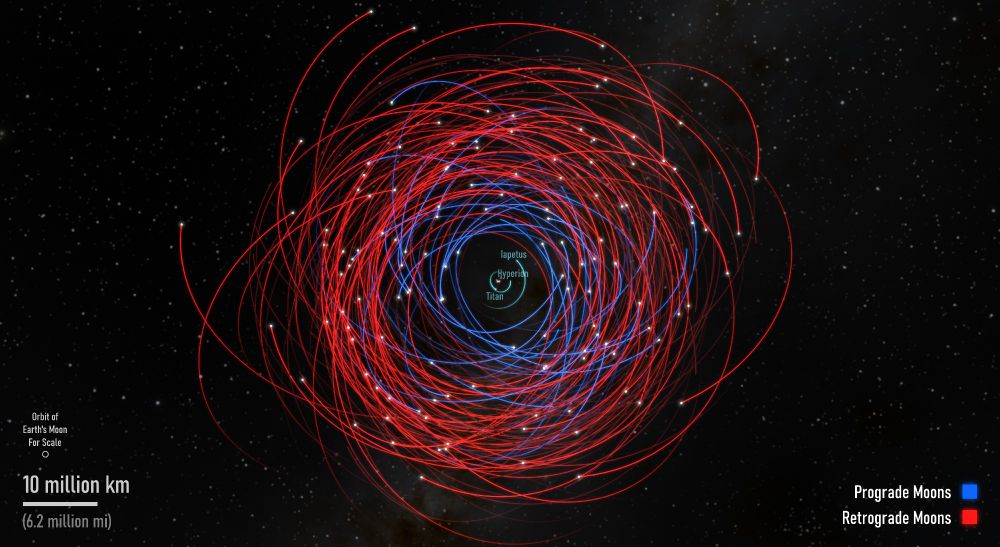
Saturn's outer moon system viewed from the north pole of Saturn. Moons orbiting in clockwise (retrograde) orbits have red-colored orbits while moons orbiting counterclockwise (prograde; in the direction of Saturn's spin) are colored blue. With so many irregular moons occupying the same region and intersecting each other, the irregular moon system looks like a donut-shaped vortex surrounding Saturn. Each of the 128 new moons is highlighted in the diagram with a white point representing their location, and a brighter-colored orbit. Previously-known moons of Saturn are included in the diagram, but are colored darker. The regular moons of Saturn are colored turquoise and the outermost regular moons (Titan, Hyperion, and Iapetus) labeled with their name. At the lower left corner are scale indicators to help visualize the scale of Saturn's irregular moon system. A small gray circle at the left left corner is shown to represent the diameter of the Earth-Moon orbital distance. A linear scale bar is labeled "10 million km" (6.2 million mi) to give a standard distance.
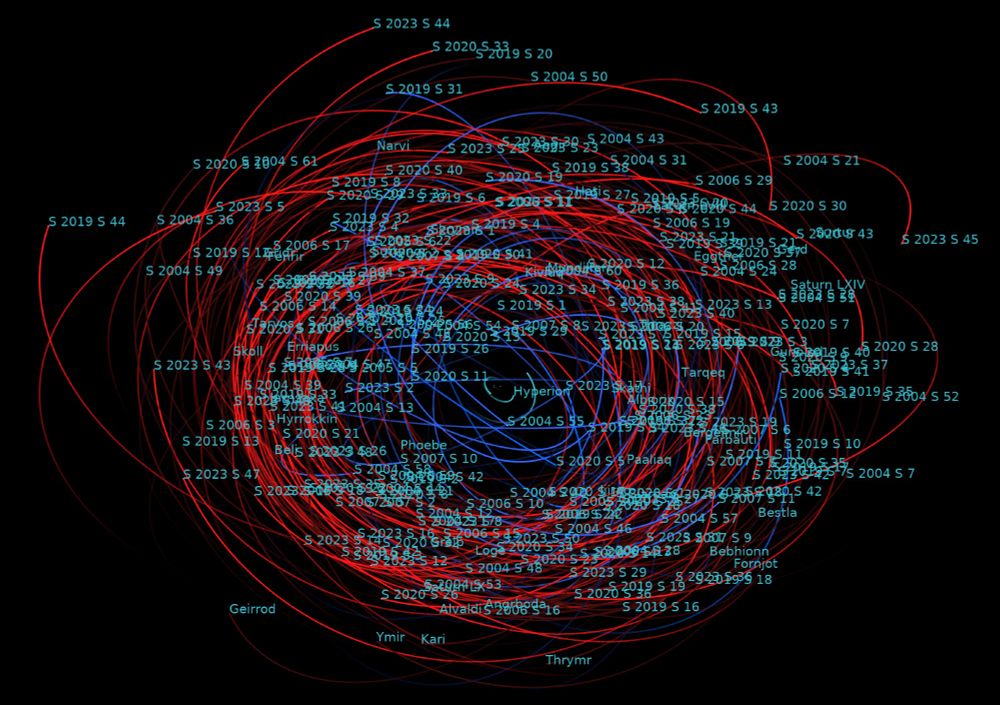
View of Saturn's irregular moon system, tilted at an angle to show the toroidal belt-like shape of the system. Each moon is labeled with their names in turquioise. Red orbits = retrograde direction, and blue orbits = prograde direction. Turquoise curves closer to the center are orbits of Saturn's regular moons.
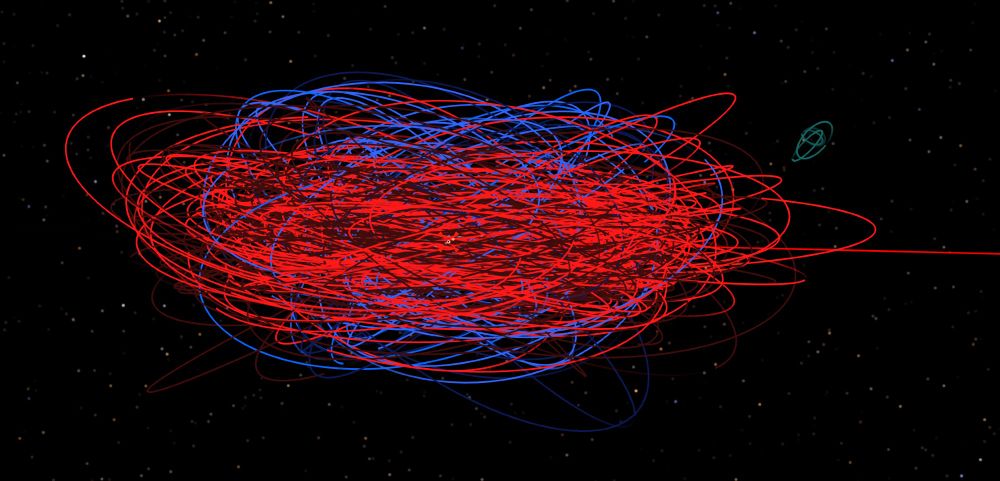
Side view of Saturn's irregular moon system, tilted at an angle to show the toroidal belt-like shape of the system. Red orbits = retrograde direction, and blue orbits = prograde direction. Turquoise curves closer to the center are orbits of Saturn's regular moons. The irregular moons of Neptune (dark green) are also visible in the background to the right of Saturn. The horizontal red line protruding right of Saturn is the orbit path of Saturn.
I spent almost 2 hours painstakingly copying the orbits of all 128 Saturnian moons from the announcement MPEC and reformatting them for visualization...
Behold, here are the orbits of ALL 128 MOONS OF SATURN. This isn't just a moon system—it's a literal asteroid belt around Saturn! 🧪🔭☄️



On the night of Jan. 29, I remotely observed the
Gaia
spacecraft using the SPIRIT 3 telescope at
@icrar.bsky.social's Mardella Observatory (IAU code E29). Farewell to this incredible mission that revolutionized our understanding of the Milky Way!
#Gaia #GBOT #astro
Here's the discovery image I took remotely from the Burke-Gaffney Observatory @BGO.observatory.social.ap.brid.gy . Follow-up photometric and spectroscopic observations of this most recent eruption of M31N 2008-12a are strongly encouraged.🔭
13.12.2024 15:00 — 👍 13 🔁 1 💬 0 📌 0Notes:
1, TCP J06330104+0303350 was discovered by Tadashi Kojima on 2024-11-28.76 at 13.9 mag, see www.cbat.eps.harvard.edu/unconf/follo...
2, Confirmation report see ooruri.kusastro.kyoto-u.ac.jp/mailman3/hyp...


Figure 1 shows the light curve I measured from the BGO data. Figure 2 shows the phase plot. My photometric data are available from the AAVSO database.
02.12.2024 04:41 — 👍 4 🔁 0 💬 1 📌 0
Yesterday, I remote observed the transient TCP J06330104+0303350= Gaia DR3 3130088774241620608 using the Burke-Gaffney Observatory (BGO @BGO.observatory.social.ap.brid.gy ). Based on my observations, it has been confirmed as an eclipsing WZ Sge-type dwarf nova with an orbital period of 0.05786 days🔭
02.12.2024 04:41 — 👍 22 🔁 1 💬 1 📌 0In addition to these two outbursts, I also led the discovery of the 2022 outburst (M31N 2022-03d). Reference: www.astronomerstelegram.org?read=15729
10.10.2024 18:49 — 👍 2 🔁 0 💬 0 📌 0The putative quiescent optical counterpart is so bright that it is clearly visible in images taken by some amateur astronomers.
10.10.2024 18:48 — 👍 0 🔁 0 💬 0 📌 0
All in all, this is a very interesting nova system. A complete model for the system will require a more thorough investigation of the quiescent counterpart, which is currently underway.
Read our paper here: iopscience.iop.org/article/10.3...
It is also posted on arXiv: arxiv.org/abs/2410.07105
🔭

In an attempt to characterize the quiescent counterpart, Prof. Shafter et al. obtained a spectrum of the putative quiescent counterpart using the Hobby-Eberly Telescope in Jan. 2023. The spectrum is dominated by a blue giant, which cannot be explained by current models.🔭
10.10.2024 16:41 — 👍 3 🔁 0 💬 1 📌 0
The counterpart of the nova is likely associated with a blue 20.5 mag variable star that displays 14.3 d period. At the distance of M31, absolute magnitude of the putative quiescent counterpart is ∼ −4, given its blue, would be unprecedented for known recurrent nova system.🔭
10.10.2024 16:39 — 👍 1 🔁 0 💬 2 📌 0
M31N 2017-01e has a recurrence time of ~2.5 yr, which is the second shortest known for any nova. After adding the two outbursts I recently discovered, the nova is known to 6 outbursts, which is the second most in the M31 galaxy. We expect the next eruption occur in Mar. 2027.🔭
10.10.2024 16:38 — 👍 1 🔁 0 💬 1 📌 0Today is paper day! Recently, I discovered two outbursts of the unusual recurrent nova M31N 2017-01e, one new (M31N 2024-08c), one old (M31N 2014-06c). After discussions with Prof. Allen Shafter from San Diego State University, an RNAAS paper was published today. 🔭
10.10.2024 16:37 — 👍 8 🔁 0 💬 2 📌 0
I made follow-up observations of this PCCP object remotely using the Burke-Gaffney Observatory (code 851) at Saint Mary's University, and the measurements are on the PCCP. ☄️🔭
04.10.2024 03:20 — 👍 4 🔁 0 💬 0 📌 0
A virtual certificate with text "Celebrating 10M users on Bluesky, #1,402,291, Jingyuan Zhao (赵经远) @astrozhao.bsky.social, joined on Oct 8, 2023"
Bluesky now has over 10 million users, and I was #1,402,291!
26.09.2024 12:11 — 👍 0 🔁 0 💬 0 📌 0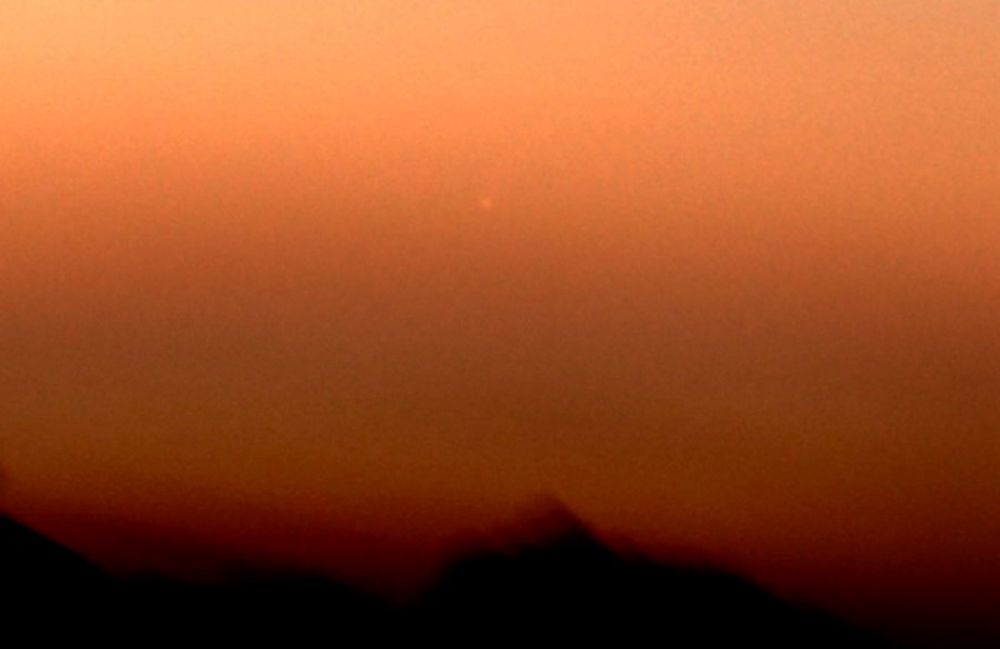
🔭We might soon have a good comet to see: skyandtelescope.org/astronomy-ne...
13.09.2024 23:08 — 👍 12 🔁 3 💬 0 📌 0
#astro
……The work encouraged many readers to study Earth and planetary sciences with its accurate depiction of celestial objects and geology."(WGSBN Bulletins Volume 4, #12)
#astro
"Ao Manaka is a character in the comic/animation Asteroid in Love created by Japanese manga artist Quro. Ao and her friends enjoy Earth Science Club activities in their high school with a dream of naming an asteroid 'Ao'……
#astro How romantic! A citizen science project helps anime characters realize their dreams in the real world!
07.09.2024 23:51 — 👍 4 🔁 1 💬 1 📌 0.🔭 🧪If you are interested, you can contact our director Xing Gao, who will communicate with you further, here is his email: gaoxing8888@sina.com
For more details about our initiative, see:
English version: xjltp.china-vo.org/tcrben.html
Chinese version: xjltp.china-vo.org/tcrb.html

According to the prediction, the recurrent nova T Corona Borealis (T CrB) will outburst in the near future, and global monitoring is very necessary. We sincerely invite amateur astronomers around the world to join our initiative on monitoring T CrB, please read the initiative below.🔭 🧪
24.07.2024 06:30 — 👍 11 🔁 1 💬 1 📌 0
🔭🧪This is a phase plot of KH 15D (V582 Mon), which is very similar to our variable star. But our variable star has a period nearly 20 times that of KH 15D, which is very interesting and may provide new clues about planet formation. Image Credit: Aleezah Ali/University of Washington
14.07.2024 01:36 — 👍 6 🔁 1 💬 0 📌 0
🔭🧪 We believe it is very similar to KH 15D, which has been called as the "Rosetta Stone" for understanding planetary formation, the brightness variations may be formed by a circumbinary disk obscuring the centre binary star. This variable star has been indexed by VSX: www.aavso.org/vsx/index.ph...
13.07.2024 10:38 — 👍 7 🔁 0 💬 1 📌 0
Our amateur team has discovered an interesting eclipsing variable star near SH 2-241 nebula from ZTF archive data. It has a period about 830 days, more than 40% in occultation, with a bright peak at the centre of the occultation. 🔭🧪
Image Credit: DSS、PanSTARRS DR1

WNYC's Radiolab and IAU are naming asteroid 164207, Earth’s quasi-moon. Submit your favorite name now!
Event Details: radiolab.org/moon-officia..., www.iau.org/news/pressre...
Nomination Website: woobox.com/wc2qxd
🔭🧪
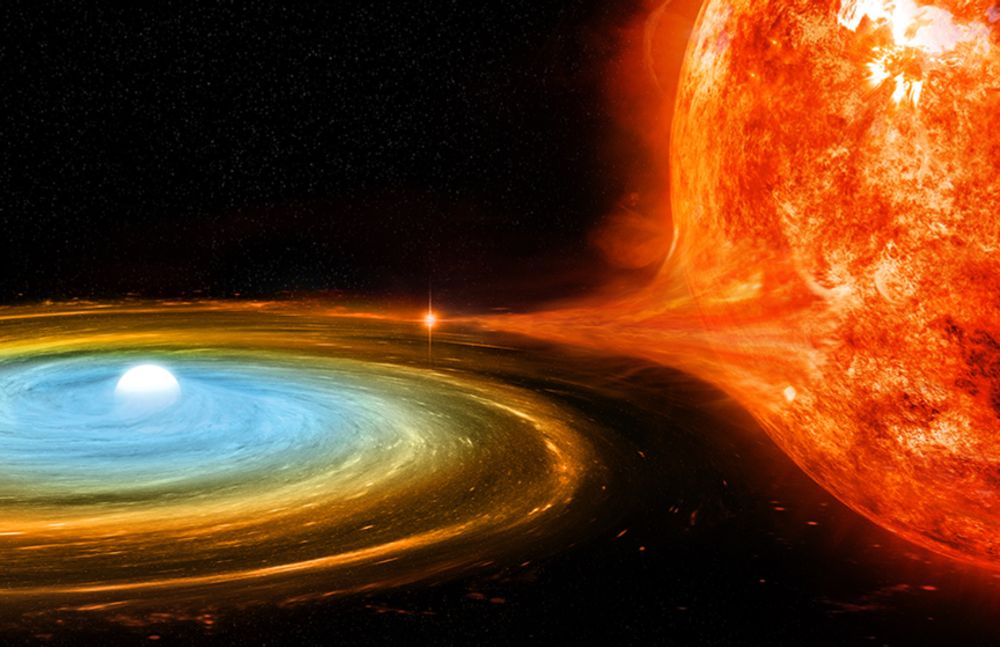
With T Coronae Borealis expected to have an outburst any day now, recurrent novae are in the news. Recently, researchers reported their investigation of a recurrent nova that brightens every year. aasnova.org/2024/05/17/s... 🔭🧪
17.05.2024 16:22 — 👍 10 🔁 6 💬 0 📌 0